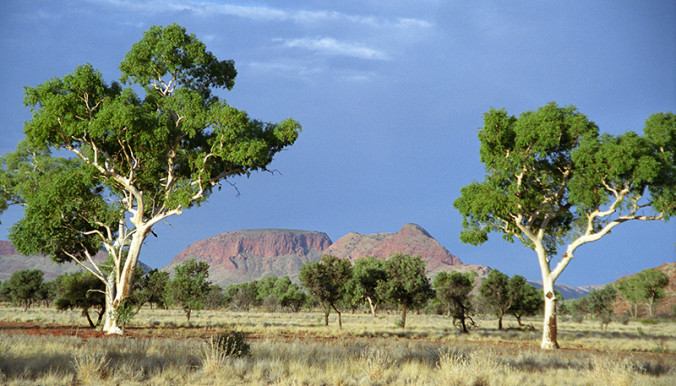This photograph was taken by my brother-in-law David Feitz. In his day he was one of the country’s outstanding photographers of the Australian outback.
This Central Australian ghost gums image is emblematic of the paintings of several Australian artists. Famous amongst them was aboriginal artist Albert Namarjira. He received international acclaim as a painter, particularly for his watercolour landscapes during the 1940s and 50s. A number of his painting were renowned for their striking white truck ghost gums that are today part of the fabric of the Australian identity. His paintings earned £50,000 between 1945 and 1949, and he became the first aboriginal Australian to be granted citizenship. He died in 1959.
The ghost gums made famous by Albert Namarjira, and other aboriginal painters are extensive over northern Australia, especially in the Northern Territory, as well as being found in limited areas of woodland near Port Moresby in Papa New Guinea.
Although mainly a tree of the tropics, ghost gums grow in dry southern parts in the Northern Territory and also inland Queensland. In southern locations ghost gums are often the only prominent tree occurring over wide areas. It is in these localities that the tree contrasts vividly with the colourful arid landscape, and has become a feature of some of Australia’s most loved paintings.
Under drier, more temperate conditions ghost gums usually occur on river flats subject to periodic flooding. Mature trees vary in size across their range, from a slender seven metres up to 25 metres. In drier areas trunks are often slender and reach five metres or more in height before the first branches occur. The bark is lustrous, smooth and white, and contrasts with the tree’s deep green, shiny leaves.
Another distinguishing feature of the inland Australia is the desert oak, one of the loveliest of all the sheoak, or casuarina trees. The desert oak is an inhabitant of dry inland areas of Central Australia where it is almost always found growing on red sandy dunes. The foliage is usually a dull green that contrasts with the background colour of the red sand. The trunk of the desert oak is dark brown, almost black and very deeply farrowed.
Usually a tree up to ten metres in height, desert oaks occasionally grows higher. The spread of its crown varies considerably, but the tree can be as broad as it is high. It has a graceful weeping habit when mature.
The sight of the desert oak on red sand near Mount Olga and Uluru, or backed by the blue Mann Ranges, is the stuff that inspires an appreciation of one of the most striking trees of dry inland Central Australia.
